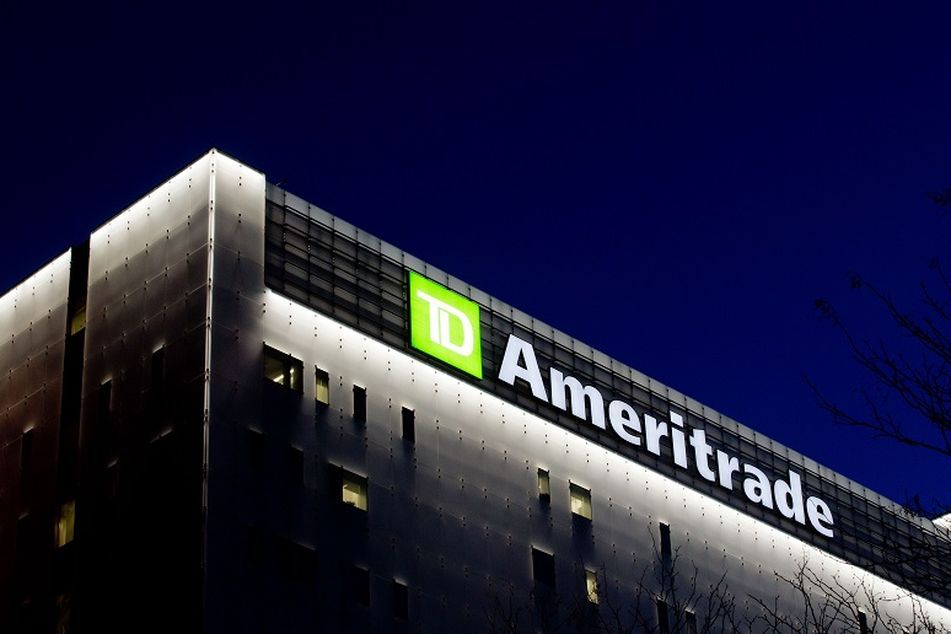TD Ameritrade cut marketing because ‘fish weren’t biting,’ CEO says
 TD Ameritrade Holding Corp. signage is illuminated atop the company's headquarters at night in Omaha, Nebraska, U.S., on Sunday, Oct. 23, 2016. TD Ameritrade and its largest stakeholder, Toronto-Dominion Bank, are close to a deal to buy online brokerage Scottrade Financial Services Inc. for $4 billion, according to people with knowledge of the matter. Photographer: Sarah Hoffman/Bloomberg
TD Ameritrade Holding Corp. signage is illuminated atop the company's headquarters at night in Omaha, Nebraska, U.S., on Sunday, Oct. 23, 2016. TD Ameritrade and its largest stakeholder, Toronto-Dominion Bank, are close to a deal to buy online brokerage Scottrade Financial Services Inc. for $4 billion, according to people with knowledge of the matter. Photographer: Sarah Hoffman/Bloomberg
Online broker sees headwinds created by lower rates and less trading.
TD Ameritrade Holding Corp. trimmed digital advertising spending because of a lack of interest from retail investors, according to chief executive Tim Hockey.
The online broker and wealth manager keeps a base level of spending and needs to see interest to ramp it up, Mr. Hockey said in a phone interview after his company’s conference call. This past quarter, “the fish weren’t biting,” he said, noting that 70% of TD Ameritrade’s marketing is digital.
Earlier, analysts had flagged the lower marketing spending as a partial explanation for why TD Ameritrade shares were falling Wednesday.
The stock fell as much as 5.5% after Ameritrade reported second-quarter adjusted earnings per share that topped analysts’ estimates by a penny.
The beat was due to lower marketing spending, Sandler O’Neill analyst Richard Repetto said via email. More ominously, “the yield curve changes aren’t favorable nor is the movement of client cash.”
In a statement accompanying the results, Mr. Hockey noted, “While net new asset growth slowed in the quarter, net new assets are up 6 percent year-to-date from last year.”
Regarding the stock slide, Mr. Hockey said in the interview that Ameritrade shares had climbed in recent days in response to other companies’ results. Though TD Ameritrade beat, it wasn’t the beat the market wanted to see, he said.
Mr. Hockey also discussed diminishing revenue growth on the company’s earnings call. During the phone interview, he blamed headwinds on lower rates, which lower returns on client cash, and less trading.
Trading fell during the company’s second quarter, even as markets rebounded, he said. Quarter-to-date, trading is still “relatively low,” but he expects investors will notice headlines about market highs and increase their trading as “FOMO sets in.” During the second quarter, average client trades per day were about 860,000, down 9% year-over-year.
In a post-call note, Citi’s William Katz expressed caution about TD Ameritrade and its peers. The company’s update did “little to assuage our concern that the group is likely to struggle” against a “more checkered macro backdrop,” Mr. Katz wrote. He’ll watch Raymond James Financial Inc.’s report post-market for client cash and engagement trends, and suspects that investors will wait until Charles Schwab’s April 26 business update “to contemplate any structural risks to the group.”
TD Ameritrade’s shares may be “reflecting some concern around metrics that suggested investors disengaged modestly following the elevated fourth quarter market volatility,” with slower net new asset additions, lighter trading and less RIA movement, JMP analyst Devin Ryan said via email. That, combined with interest rate pressure, has “muted the revenue picture.”
Even so, Mr. Ryan said he thinks “much of this is both backward-looking and transitory, and we remain constructive on the growth outlook.”
TD Ameritrade has gained 13% since the Dec. 24 market bottom, versus a 20% increase for ETrade and 18% for Schwab.
Learn more about reprints and licensing for this article.








